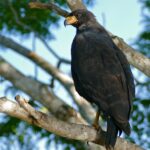Great Black Hawks (Buteogallus urubitinga) are known to feed on a wide variety of small creatures, including frogs. These birds of prey are found in the United States, as well as in the tropics, and their diet can vary depending on their location.
Do Great Black Hawks Eat Frogs?
Yes, Great Black Hawks do eat frogs as part of their diverse diet. In the United States, they are known to feed on fish, frogs, tadpoles, and lizards, as well as small birds, snakes, rodents, and insects. In the tropics, their diet may also include crayfish, crabs, and large insects.
Hunting Behavior of Great Black Hawks
 Image source: Great Black Hawk by Bernard DUPONT
Image source: Great Black Hawk by Bernard DUPONT
Great Black Hawks are skilled hunters that use a variety of techniques to catch their prey. They often watch for prey from a low perch and then swoop down to catch it in their talons. They may also hunt actively along streams, wading in shallow water and stirring up prey.
Perch and Pounce Hunting
One of the most common hunting techniques used by Great Black Hawks is the “perch and pounce” method. They will sit on a low perch, such as a tree branch or rock, and scan the area for potential prey. When they spot a frog or other small creature, they will swoop down and catch it in their powerful talons.
Wading and Hunting
Great Black Hawks are also known to wade into shallow water to hunt for prey. They may walk along the edges of streams and ponds, stirring up the water to flush out frogs, tadpoles, and other aquatic creatures. Once the prey is exposed, the hawk will quickly strike and capture it.
Habitat and Distribution of Great Black Hawks
Great Black Hawks are found in a variety of habitats, but they are particularly associated with the edges of flowing streams in arid southwest habitats in the United States. They are non-migratory in most of their range, but in the United States, they are only summer visitors, arriving in March and departing in September and October.
Habitat Preferences
Great Black Hawks prefer habitats with access to water, such as the edges of streams, rivers, and ponds. They are often found in areas with a mix of open and wooded areas, which provide them with both hunting perches and cover.
Population Status
In the United States, Great Black Hawks are considered vulnerable due to disturbance and habitat loss. It is estimated that there may be as few as 250 pairs of Great Black Hawks in the country.
Physical Characteristics of Great Black Hawks
Great Black Hawks are large, bulky birds with broad wings and long legs. They have a distinctive appearance that sets them apart from other hawk species.
Plumage and Coloration
Adult Great Black Hawks are entirely black, while juveniles are brown and buff with narrow tail bands and a patterned face. They have a single obvious white tail-band that is a key identifying feature.
Wing and Tail Shape
Great Black Hawks have a broad, fingered wing shape and a rounded, square-tipped tail shape. These features help them to maneuver effectively while hunting and flying.
Vocalization
The call of the Great Black Hawk is a shrill, whistled scream with a rising, simple pattern. This call can be heard as they soar over their territory or when they are defending their nest.
Conclusion
In summary, Great Black Hawks are known to eat frogs as part of their diverse diet, which also includes fish, small birds, snakes, rodents, and insects. These skilled hunters use a variety of techniques, including perching and pouncing, as well as wading in shallow water to catch their prey. While they are found in a variety of habitats, they are particularly associated with the edges of flowing streams in the arid southwest of the United States. Unfortunately, their population in the US is vulnerable due to disturbance and habitat loss.
References:
- Audubon Field Guide – Common Black Hawk. Retrieved from https://www.audubon.org/field-guide/bird/common-black-hawk
- Great Black Hawk – Buteogallus urubitinga – Carnivora. Retrieved from https://carnivora.net/great-black-hawk-buteogallus-urubitinga-t5726.html
- Great Black Hawk – Buteogallus urubitinga – Birds of the World. Retrieved from https://birdsoftheworld.org/bow/species/grbhaw1/cur/introduction


